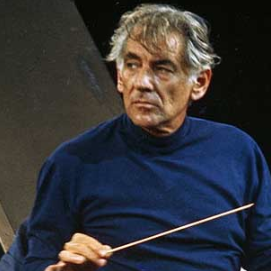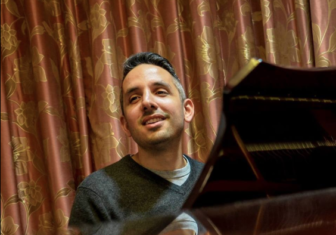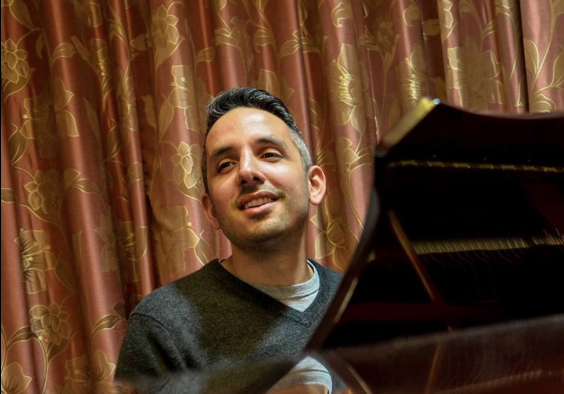Darien Library presents a new four-week, Tuesday lecture series on music and faith taught by Gil Harel. (Watch his previous lectures.) All lectures take place from 7 to 8 p.m. in the Community Room at Darien Library, starting this Tuesday, Nov. 20.
— announcements from Darien Library
The Renaissance to J.S. Bach
This Tuesday, Nov. 20 at 7 p.m.
The study of what scholars call “early music” is dominated by the works of composers whose faith informed and inspired their creativity.

Johann Sebastian Bach (aged 61) in a portrait by Elias Gottlob Haussmann, copy or second version of his 1746 canvas. — Caption from Wikimedia Commons
While music played a role in every aspect of European life, few people had the skill to notate and thus preserve their works for posterity.
Thus, most of the music that survives from this early period is associated with the Catholic Church and the clergy who possessed the training to translate sounds into arcane symbols that became modern musical notation.
This early period of music history culminated in the life and works of Johann Sebastian Bach, a German Lutheran whose works continue to inspire today. With Bach, we see the apex of baroque liturgical music represented in the impressive body of works known as “cantatas.”
Liturgical Music in the Age of Enlightenment: Mozart and Haydn
Tuesday, Nov. 27 at 7 p.m.
European society changed dramatically in the second half of the 18th century, and as it did, so did the role of music in the church.

This painting, regarded by historians as the most accurate surviving likeness of Mozart, was created when the composer was 26 years old. It is a section of an unfinished 1782 portrait by Joseph Lange. The splotchy texture of the composer’s cheeks, visible in the original painting on display at the Mozart Museum in Salzburg, was verified by Mozart’s contemporaries. — caption from Wikimedia Commons
In this era where philosophers touted the supremacy of reason over dogma, liturgical music often took on the characteristics of then-contemporary music. In this era, melody was king and simple, homophonic textures prevailed.
Franz Josef Haydn is often credited as the “father” of the symphony and the string quartet, but he was also a prolific writer of church music.
Here we will consider his “Missa in tempore belli” (Mass in Time of War), written during the tense years preceding the Napoleonic Wars.
Mozart’s approach to church music incorporates different everything from baroque counterpoint to soaring operatic melody. Both are on display in his C Minor Mass.
From Beethoven’s Missa Solemnis to Verdi’s Requiem
Tuesday, Dec. 4 at 7 p.m.
Beethoven’s name does not immediately conjure up church music, and yet the composer himself was said to have considered his Missa Solemnis to be among his finest works.

Ludwig van Beethoven, a portrait by Joseph Karl Stieler, 1820
This “Solemn Mass” is a testament to the composer’s ambition (the work clocks in at over 80 minutes and present the performers with significant challenges), as well as his dedication to mastering the styles of the past.
In Verdi’s Requiem, we have a curious example of a non-operatic work created by a composer associated almost exclusively with opera.
In the finale to this masterpiece, The Catholic Verdi’s style reflects – as we have observed with Mozart and Beethoven – the indelible impact of the Lutheran, J.S. Bach.
Music, Religion, and the Modern Era: Leonard Bernstein
Tuesday, Dec. 11 at 7 p.m.
For many listeners, classical music of the 20th century is polarizing. Beginning with composers such as Igor Stravinsky and Arnold Schoenberg, dissonance and instability began to supplant traditional approaches to melody and harmony.

Photo by Allen Warren, via Wikimedia Commons
Leonard Bernstein, 1973
This new and somewhat radical style was applied to seemingly every style of music, from ballet to chamber music to concerti, as well as religious music.
For many people, this latter point seemed to suggest a paradox: after all, how could religious music capture the beauty and sublime nature of spirituality if it was filled with crunchy dissonances and incoherent rhythms?
The Jewish-American composer Leonard Bernstein tackled this exact issue in his Chichester Psalms. Composing during the 1960s, Bernstein set no fewer than six psalm quotations, each imbued with memorable musical characteristics ranging from septuple meter (7/4) to harmonies suffused with modernistic qualities while remaining rooted in tonality.
In this work, Bernstein achieves a uniquely modern sound while rooting the work in familiar territory. Surely this is what J.S. Bach might have called “well-regulated church music.”
- Can’t make one of the live events? Check out the video recording afterward at DarienLibrary.tv.
_______________
About the Presenter
Gil Harel (PhD, Brandeis University) is a musicologist and music theorist whose interests include styles ranging from classical repertoire to jazz and popular music, as well as opera, medieval, and renaissance music.

Photo from Dr. Gil Harel Lectures Facebook account
Gil Harel
Previously, he has served on the faculty at CUNY Baruch College, where he was awarded the prestigious “Presidential Excellence Award for Distinguished Teaching”, as well as the Southwestern University of Finance and Economics in Chengdu, China.
Currently, he teaches at Naugatuck Valley Community College, where he was recently presented with the coveted “Merit Award for Exemplary Service to the College.”
At NVCC, Dr. Harel conducts the college chorale, teaches music history and theory, and serves as musical director of theater productions. Outside of teaching, he enjoys staying active as a pianist and vocalist.


